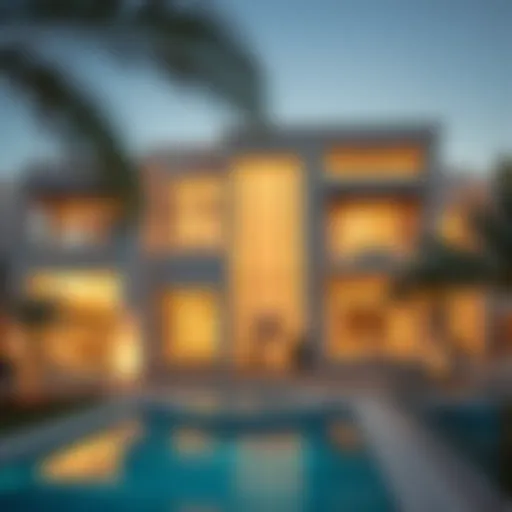Exploring Emirati Houses: Architectural Heritage and Modernity
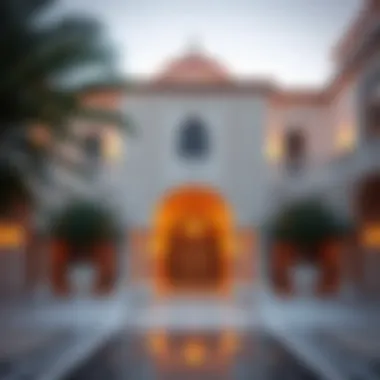

Intro
The architectural landscape of the UAE, especially Dubai, presents a tapestry woven with the threads of cultural heritage and contemporary flair. Emirati houses stand as sentinels of history, offering deep insights into the life and traditions of the Emirati people. As the nation strides forward, the evolution of these homes reflects not just architectural trends but also a significant shift in lifestyle, influenced by global design principles and shifting cultural dynamics. Understanding this evolution is vital for anyone looking to navigate the multifaceted real estate market in Dubai.
In this article, we will embark on a journey through the intricacies of Emirati houses, starting with a closer look at property listings. This includes both traditional and modern structures that embody the region’s spirit.
We’ll also delve into the buying process, including tips and considerations for international buyers keen on investing in this captivating market. Whether you are a seasoned real estate investor, an expatriate considering a move, or a family seeking the comfort of a home, this guide aims to equip you with the knowledge needed to make informed decisions.
Foreword to Emirati Houses
Emirati houses are more than mere structures for shelter; they embody the essence of a culture that has flourished over centuries in a harsh desert environment. Understanding these houses is crucial for anyone interested in the architectural heritage and contemporary evolution of the United Arab Emirates. Not only do they reflect the lifestyle and traditions of the Emirati people, but they also showcase how architecture can both maintain historical significance while adapting to modern needs.
Cultural Significance
The architecture in the UAE, particularly the homes, serves as a testament to its rich history. Traditional Emirati houses tell stories of resilience against the elements and a deep connection with the surrounding land. The use of specific materials, such as coral stone and mud, harks back to an era when resources were locally sourced and ingeniously utilized. From wind towers designed to catch cool breezes to courtyards providing privacy and space for family gatherings, each element is carefully thought out.
Adaptation and Modern Relevance
As the UAE transformed into a global hub of commerce and tourism, the traditional dwelling has evolved. Newer structures may incorporate modern materials and technology, answering the demands of a diverse population, yet they still pay homage to the past. This blend of antiquity and innovation creates a tapestry of architectural styles that reflect both heritage and progress.
"The evolution of Emirati houses is a mirror of the nation's journey from tradition to modernity, showcasing how architectural forms can embrace change while preserving roots."
Benefits for Stakeholders
For real estate investors and expatriates looking to buy in the UAE, understanding the architectural foundations—and the traditional nuances embedded in them—can yield significant benefits. Recognizing how these houses can feature luxurious finishes while respecting ancestral designs creates opportunities for premium investments. Likewise, families will find immense value, both emotionally and financially, in homes that are not only aesthetically pleasing but historically significant.
As we embark on this exploration, it's essential to grasp the implications of these architectural designs on the contemporary landscape and how they signify a unique blend of history and modern life. Whether you're drawing plans for an investment or simply curious about Emirati culture, the house serves as a pivotal element in the narrative of the nation.
Historical Context of Emirati Architecture
The architectural legacy of the Emirates is not merely a backdrop for its stunning landscapes; it represents a living narrative of cultural evolution and adaptation over time. Understanding the historical context of Emirati architecture offers insights into how environmental factors, societal changes, and influences from neighboring regions have shaped building practices and styles.
In the past, Emirati houses were designed to not only provide shelter but also to reflect the values and lifestyles of their inhabitants. For instance, in the harsh climates of the desert regions, the architectural focus on functionality—such as natural cooling systems—was crucial for enhancing comfort in both urban and rural settings. This historical backdrop sets the stage for the exploration of traditional and contemporary aspects of Emirati houses.
Early Influences
The architectural framework in the UAE is heavily influenced by its rich historic interactions with various cultures. Long before the era of modern buildings, the region saw influences from Persian, Indian, and various Gulf States. Trade routes crisscrossing the Arabian Peninsula facilitated the exchange of not just goods but ideas. The result? A blend of styles that can be observed in the homes that sprouted along coastlines and inland.
A notable influence includes the traditional mud-brick construction techniques that teem with practicality and resilience. The reliance on local materials is not only cost-effective but also sustainable. The use of coral stone and palm fronds, for example, exemplifies how the Emirati people used resources at hand.
Traditional Materials and Techniques
When it comes to materials, the past informs the present in remarkable ways. Traditional houses were constructed with materials that were accessible and suitable for the warm climate. Key among these were:
- Mud bricks: Used extensively for their thermal efficiency, keeping homes cool in the blistering heat.
- Palm fronds: Often utilized for roofing and walling, showcasing a connection to the natural environment.
- Limestone and gypsum: Commonly found in older structures, these materials played vital roles in stability and durability.
The craftsmanship in construction during this era was impressive, with techniques passed down through generations. This knowledge of utilizing local resources aided in establishing a sense of identity among Emiratis, making houses not just a place to live but a reflection of cultural heritage.
From the methods to the materials, each home tells a story. With the ongoing reclamation of traditional architecture and a renewed appreciation for indigenous methods, this section underscores a pivotal theme: the architecture not only provides shelter but embodies the history and resilience of its people.
"Building a home is more than just placing bricks; it’s a connection to culture, environment, and community."
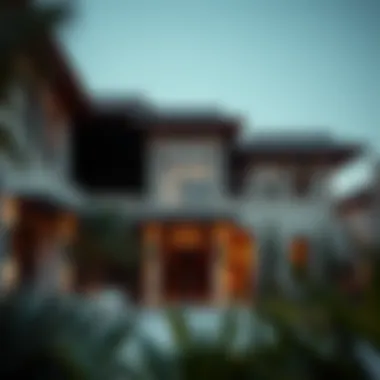

Through understanding these early influences and traditional practices, readers can appreciate how they resonate within contemporary building designs in the Emirates, paving the way for modern adaptations while still cherishing the roots that shaped them.
Defining Features of Traditional Emirati Houses
Understanding the defining features of traditional Emirati houses is instrumental in appreciating the unique architectural heritage that reflects the cultural and social evolution of the UAE. These houses serve not only as a shelter but also as living examples of the ingenuity and adaptability of the people who live in this region. The significance of these elements lies in their ability to meld functionality, climate considerations, and aesthetics into a cohesive design. Without a doubt, they offer invaluable insights into the lifestyle, history, and environmental context of the Emirates.
Wind Towers: Functional Aesthetics
Wind towers, or barjeel, feature prominently in many traditional Emirati houses. They stand as silent sentinels, gracefully rising above the rooftops, designed to capture even the slightest breeze. The ingenious structure of these towers allows hot air to escape, creating a natural cooling effect inside the house. This aspect is vital in the sweltering desert climate, where temperatures can soar, making life indoors a challenge without modern air conditioning.
The aesthetic of the wind tower encapsulates a blend of function and artistry. Their placement is carefully thought out; often, houses are oriented strategically to maximize airflow. It's not just about practicality; many wind towers are carved beautifully, integrating elements of Islamic and traditional designs. As one walks through an Emirati neighborhood, the distinctive silhouettes of these structures tell a story of time-tested solutions to climatic challenges. In a way, they embody the resilience and resourcefulness of Emirati culture.
Courtyards: Inner Sanctuaries
Another crucial feature of traditional Emirati houses is the courtyard, which has historically served as the heart of family life and social gatherings. These open spaces create a serene oasis amidst the bustling exterior environment. Courtyards often house lush gardens or water features, providing a shade-filled sanctuary where families can relax and enjoy each other's company.
It is worth noting that these inner sanctuaries are designed with privacy in mind. High walls enclose them, allowing residents to engage with nature while shielding themselves from the outside world, reinforcing the Emirati value of family and communal living. Courtyards also enhance ventilation, as they facilitate airflow throughout the house, offsetting the heat of the day.
Decorative Elements: Artistry in Stone and Wood
The artistry of traditional Emirati houses shines through their intricate decorative elements, showcasing a deep appreciation for craftsmanship. Engravings and carvings adorn walls, doors, and window frames, often featuring motifs inspired by nature and Islamic geometry. These designs are not merely decorative; they tell stories passed down through generations, reflecting the values and beliefs of the Emirati people.
Wooden doors, especially, exhibit remarkable craftsmanship, often embellished with bright paint or intricate carvings that symbolize good fortune and protection. On the other hand, the use of stone in construction not only lends durability but also provides a cool atmosphere within the house, embodying yet another ingenious approach to climate control.
"Through the lens of their architecture, Emirati houses reveal much about the cultural values of their inhabitants and offer a sense of identity that remains deeply rooted in history."
Regional Variations in Emirati Housing
Understanding regional variations in Emirati housing offers a profound insight into how different communities within the UAE adapt their architectural styles in response to geography, culture, and lifestyle. The essence of Emirati housing transcends mere aesthetics; it's a reflection of the people who inhabit these spaces and their unique identities.
Urban vs. Rural Designs
City slickers and country folks live in worlds apart in the UAE. In urban environments like Dubai and Abu Dhabi, houses are often characterized by sleek lines, modern materials, and an emphasis on space efficiency. High-rise buildings dominate the skyline, but traditional styles are emerging within developments, such as Al Fahidi Historical Neighborhood. These homes incorporate classic architectural features like wind towers and courtyards while utilizing modern amenities.
Conversely, rural designs highlight a more straightforward and organic approach. In places like Al Ain, you may find homes made from locally sourced materials like mudbrick or date palm fronds. These structures are designed to withstand the climate concerns typical in desert regions. The layout often encourages family gatherings, focusing on shared spaces rather than individualized spheres. Wide verandas or shaded areas are common, offering respite from the harsh sun.
The juxtaposition of urban flash and rural simplicity speaks volumes. Urban housing embraces global trends, whereas rural designs hold onto their cultural roots, ensuring they continually evolve while remaining true to their origins.
Cultural Influences on Architecture
Cultural influences molding Emirati housing cannot be overstated. The UAE has a rich tapestry woven from various threads—Islamic, Arabic, and Persian influences all interlace to shape the homes built here. Islamic architecture, for example, plays a significant role in informing many aspects of design. This is evident in arches, intricate tile work, and geometric patterns, which invoke a sense of spirituality and connection to the land.
Moreover, the diverse expat population brings international styles and ideas that blend seamlessly into the local architecture. It’s not uncommon to see a villa with Mediterranean flair nestled among traditional courtyard homes. Such hybrid architectural styles encourage a dialogue between cultures. Likewise, art from local artisans often finds its way into these residences, adding a touch of the unique Emirati heritage.
The infusion of varied cultural elements helps foster a community spirit and encourages understanding among the different resident demographics. As these influences continue to shape the architectural landscape, they bring a fresh perspective to the traditional Emirati housing model.
Quote:
Modern Adaptations of Emirati Houses
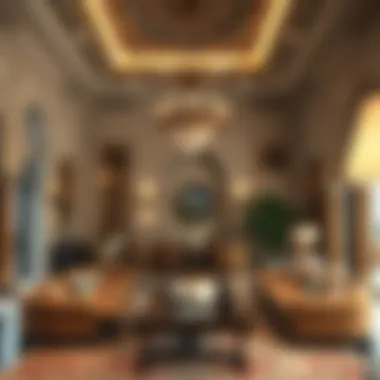

The architectural landscape of the UAE is seeing a transformative shift, particularly in how traditional Emirati houses are being adapted for modern living. These adaptations not only maintain the cultural essence embedded in the designs but also cater to the demands of contemporary lifestyles. Understanding these modern adaptations is crucial, especially for real estate investors and expatriates who seek to appreciate both the heritage and functionality of housing in the region.
Fusion of Tradition and Modernity
One of the most striking features of modern Emirati houses lies in their ability to fuse traditional architectural elements with modern design principles. This blend is not just a trend; it is a response to the growing diversity of the Emirati population.
- Use of Traditional Materials: Many new constructions still incorporate traditional materials like coral stones and mud, which have been used for centuries. This respect for historic resources keeps the connection with the past while ensuring longevity and aesthetic value.
- Open Floor Plans: A shift can also be seen in the layout of homes. While traditional Emirati houses focused on segmented rooms, modern designs embrace open floor plans. This open space promotes community bonding and enhances natural light, creating inviting environments for family gatherings and social interactions.
- Contemporary Amenities: Modern adaptations often include contemporary amenities such as smart home technology and sustainable heating and cooling systems. This integration demonstrates a commitment to comfort without abandoning aesthetic significance.
"In today’s UAE, the charm of traditional architecture comes alive through modern innovation."
The careful blending of these diverse elements results in homes that not only tell a story but also function effectively in a fast-paced lifestyle.
Sustainable Practices in New Constructions
As the world turns its attention to sustainability, the construction of Emirati houses is no exception. In fact, there's a growing emphasis on creating homes that are not only beautiful but also environmentally responsible.
- Energy Efficiency: Many new homes are designed with energy efficiency in mind. This includes installing solar panels and utilizing advanced insulation techniques to control heat loss, which is essential in the desert climate.
- Water Conservation: Given the arid landscape of the UAE, modern Emirati houses increasingly focus on water-saving features. This includes rainwater harvesting systems and greywater recycling, which makes a significant impact on reducing overall water usage.
- Green Spaces: Urban sprawl has made outdoor spaces more critical than ever. Many modern homes now emphasize landscaping that promotes sustainability, using native plants that require less water and are well adapted to the local environment.
These efforts towards sustainable construction not only enhance the quality of living but also make financial sense in the long run, ensuring that this architectural heritage remains viable and relevant for future generations.
The Role of Emirati Houses in the Contemporary Real Estate Market
Analyzing the role that Emirati houses play in the real estate landscape is paramount for anyone looking to make informed decisions in the rapidly evolving market. The architectural legacy interwoven with modern lifestyle aspirations creates a unique tapestry that appeals to a diverse array of buyers—from expatriates to local families seeking permanence in a world that often feels temporary.
Investment Opportunities in Dubai
Dubai stands as a beacon for real estate investments, promising vast opportunities. The value of Emirati houses stems not just from their aesthetic appeal or cultural significance, but also from their ability to provide tangible returns. Consider the following elements that make investing in such properties lucrative:
- Location: Prime areas like Dubai Marina or Downtown Dubai offer properties that maintain high demand, predominantly fueled by expatriates and wealthy locals.
- Cultural Appeal: Properties that celebrate traditional architectural styles often attract buyers interested in the heritage and authenticity they represent, which can increase their resale value.
- Rental Yields: With tourism continually opening its doors wider, investing in an Emirati house can yield considerable rental income, particularly for short-term vacation rentals.
Overall, the blend of tradition and modernity not only provides a unique living experience but also fortifies the investment potential over time. Investors should ensure they’re up to date with local zoning laws and community regulations as changes in these areas can significantly affect property values.
Market Trends and Buyer Preferences
Shifts in buyer preferences dictate the dynamics of the real estate market, and Emirati houses are no exception. To grasp these trends, we should focus on several key aspects:
- Modern Amenities: Buyers increasingly seek properties that marry traditional designs with smart home technologies and modern conveniences. The fusion creates homes that resonate well with various lifestyle preferences.
- Eco-Friendly Features: A surge in interest for sustainable living means that houses incorporating energy-efficient designs and materials are now trending, indicating that buyers are conscientious about their environmental impact.
- Community Living: More buyers prioritize homes in neighborhoods that foster community engagement and social connection. Properties in well-planned developments with shared facilities may attract premium pricing and quicker sales.
In summary, understanding market trends and buyer preferences presents an opportunity for real estate investors to tailor their offerings effectively. For those wishing to delve deeper into these aspects, local resources may provide invaluable insights. Sources like Dubai Land Department and property forums on Reddit can be particularly enlightening.
Investing in Emirati houses not only reflects appreciation for a rich architectural heritage but also aligns with contemporary market dynamics, making it a prudent choice for savvy real estate navigators.
Essential Considerations for Buying Emirati Property
Purchasing property in the UAE, especially in Emirates like Dubai, is a landscape filled with opportunities. With its swift economic growth, vibrant lifestyle, and a melting pot of cultures, many are finding immense appeal in integrating into Emirati society through real estate investments. However, before taking a dive into such a vibrant market, it’s crucial to consider several factors that can significantly influence the process and outcome of property investment.
Understanding Local Regulations
Navigating the real estate regulations in the UAE can be akin to walking through a maze, given that the rules can differ substantially between various emirates. For instance, Dubai has its own set of laws governing property ownership, foreign ownership percentages, and even specific requirements for contracts. Hence, understanding these frameworks can be vital.
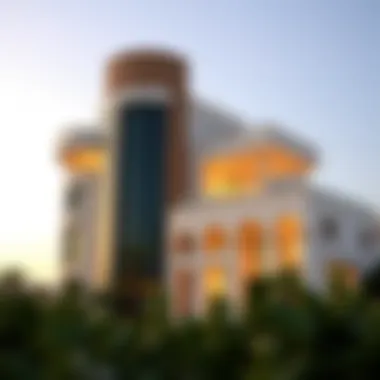

- Freehold vs. Leasehold: Expats often need to be aware of the difference between freehold properties, where one holds the title outright, and leasehold, where ownership is granted for a specified period, typically 99 years.
- Transfer Fees: Upon purchasing the property, buyers generally need to pay a transfer fee. In Dubai, this is around 4% of the purchase price unless agreed otherwise in the contract.
- Registration Process: The property registration is handled by the Dubai Land Department, and prospective buyers are encouraged to engage a local attorney or real estate consultant to streamline this task.
Familiarizing oneself with these local regulations isn’t just suggested, it’s imperative to avoid unforeseen obstacles down the line.
Financing Options for Buyers
When it comes to financing a property in the UAE, options can be as varied as the buyers themselves. Many buyers, particularly expats, often contemplate whether to purchase outright or seek financing to alleviate upfront costs. Understanding the financing landscape can make a world of difference.
- Mortgage Availability: Many banks in the UAE offer mortgages to expatriates, though it’s essential to know that terms can differ widely. Typically, banks may finance up to 75-80% of the property value for expats.
- Interest Rates: With rates fluctuating, it’s important to shop around. Some banks offer both fixed-rate and variable-rate mortgages, so it’s wise to evaluate which aligns better with an individual’s financial strategy.
- Down Payment: Be prepared to make a substantial down payment, as many banks require at least 20-25% of the property's price for foreign investors. This varies based on the lending institution and the property type.
"Navigating the waters of property investment in the Emirates can be tricky, but being well-prepared can help steer you clear of rocky shores."
For more detailed information on regulations and financing options, please refer to the official sites like Dubai Land Department and seek tailored advice based on individual circumstances.
Emerging Neighborhoods and Communities
As the urban landscape of the UAE continues to evolve, the emergence of new neighborhoods and communities becomes imperative to understand—particularly for those interested in the real estate market. New developments often blend tradition with modernity and offer unique living environments tailored to diverse lifestyles. The growing demand for housing in urban areas reflects a shift towards more integrated and vibrant communities. But as these neighborhoods arise, various factors come into play that are important for potential buyers and investors.
Gentrification Effects in Urban Areas
Gentrification is a term often thrown around when discussing urban development, but what does it truly mean in the context of Emirati cities? On one hand, it can signal the revitalization of a neighborhood, breathing life into once-neglected areas. New businesses may pop up, parks can be established, and infrastructure gets upgraded. For example, an older neighborhood may see the introduction of trendy cafes and art galleries, drawing younger crowds and creating a fresh vibe.
However, gentrification often comes hand in hand with challenges. Long-time residents might find themselves priced out as property values increase. This kind of shift can erase the rich cultural tapestry that once characterized the area. Moreover, the displacement of local communities threatens to dilute the cultural identity that these neighborhoods hold dear. It’s a double-edged sword that local governments and planners must navigate carefully. The question often posed is: how to balance growth with inclusivity?
"As neighborhoods transform, the underlying narratives of their histories must not be overshadowed by the allure of modern development."
Community Development Initiatives
Community development plays a vital role within the context of the UAE’s evolving neighborhoods. Initiatives that prioritize local needs can foster a sense of belonging, which is crucial in a multicultural society like the UAE. Various organizations and government entities are stepping up to support local communities with programs that focus on cultural preservation and social cohesion.
For instance, initiatives may include educational programs designed to empower residents with knowledge about sustainable living practices. Such practices, which can be integrated into modern construction methods, not only benefit the environment but also instill a sense of pride among community members.
Here are some essential community development initiatives worth noting:
- Cultural Festivals: Celebrating local heritage through events that bring people together.
- Public Spaces: Creating parks and recreational areas encourages community interaction.
- Skill Development: Programs aimed at equipping residents with vocational skills can promote employment and self-sufficiency.
As neighborhoods develop, fostering a sense of community is key to ensuring that these areas remain desirable places for families and expatriates. By focusing on inclusive growth, Emirati neighborhoods can thrive within a framework that respects their past while embracing the future.
Finale on Emirati Houses and Their Future
Emirati houses stand as a testament to the rich architectural heritage and cultural narrative of the United Arab Emirates. As we draw together the threads explored throughout this article, it becomes clear that these homes are much more than mere structures; they encapsulate a way of life, a history steeped in tradition, and an adaptation to the modern world.
The importance of this topic lies in the ongoing evolution of Emirati houses as they adapt to the demands of contemporary society. These homes reflect both the environmental and technological advancements while still paying homage to the traditional elements that define Emirati architecture. For investors and families alike, understanding the transformation of these houses holds valuable lessons on sustainability, cultural identity, and market trends.
Key Considerations:
- Cultural Relevance: As regional and global influences seep into architectural design, it’s crucial to retain the essence of what makes Emirati homes unique. The traditional wind towers and courtyards must blend with modern aesthetics without losing sight of their cultural significance.
- Market Dynamics: The real estate market in Dubai is rapidly evolving. Recognizing the value of traditional homes in a landscape that increasingly favors modern constructions can provide lucrative investment opportunities for discerning buyers who see beyond the conventional.
- Sustainability: With a growing emphasis on eco-friendly building practices, future Emirati houses are likely to incorporate sustainable materials and energy-efficient solutions. This not only enhances the livability of these homes but also aligns with global environmental standards.
"The challenge and opportunity lie in bridging traditional practices with modern requirements, ensuring that the future of Emirati houses reflects both heritage and innovation.”
Looking Forward
As families and investors consider relationships with Emirati housing, it’s essential to remain perceptive of both the architectural and market shifts. The future poses an interesting juxtaposition of tradition and modernity, where the Abu Dhabi skyline marries luxury with cultural authenticity. Investing in Emirati houses today means stepping into a legacy—one where each brick tells a story, each design choice reflects a cultural narrative, and where the future remains bright and bountiful.
In summary, Emirati houses are not static entities but dynamic symbols of a nation’s identity. Their evolution will continue to resonate with those wishing to partake in the UAE's extraordinary journey. As such, whether you are a potential buyer or simply a curious observer, grasping this architectural heritage is essential to navigating the intricate real estate landscape in the UAE.

